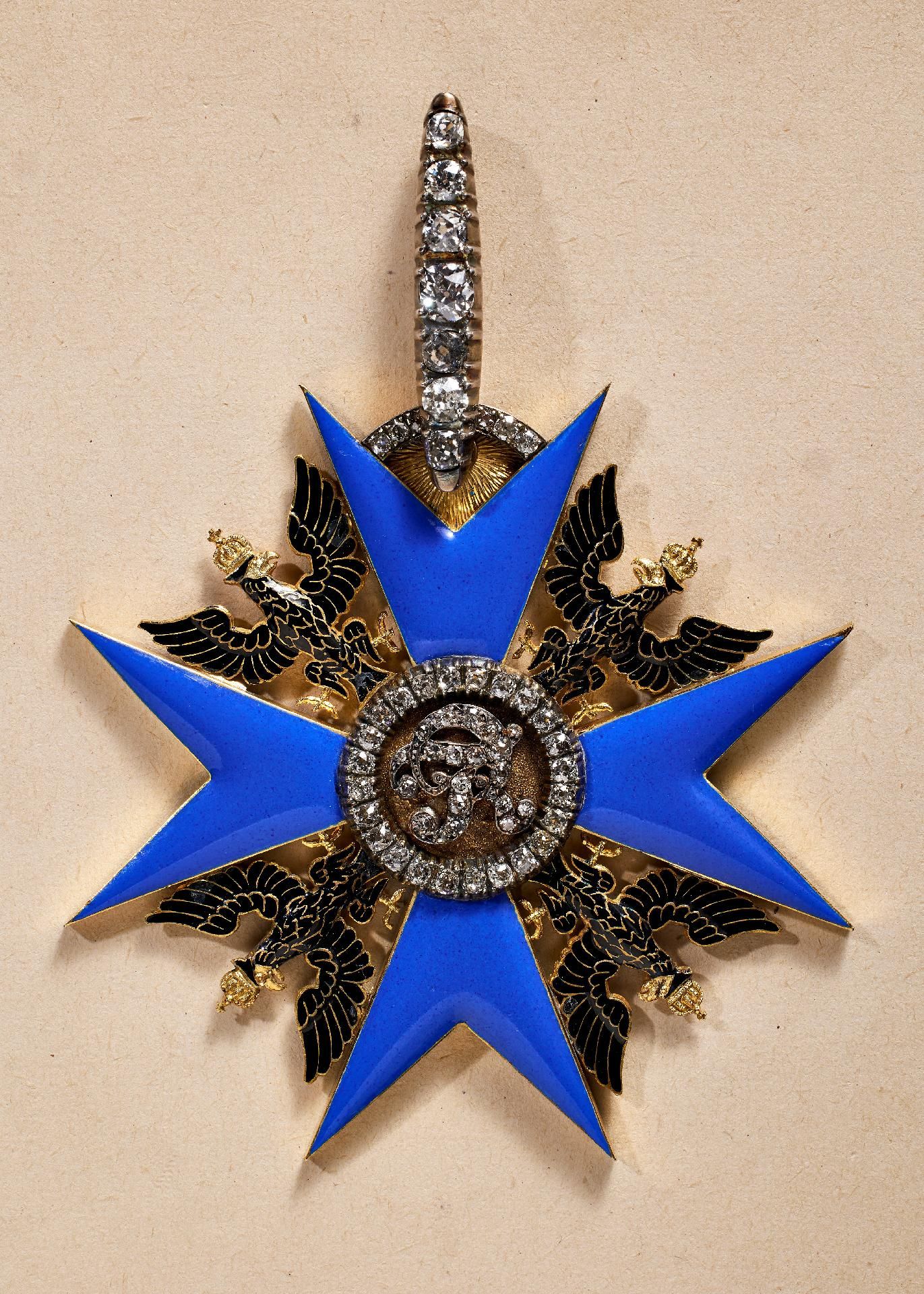Description
Orders & Decorations Germany - Prussia : Kingdom of Prussia: Black Eagle Order - Order Cross in diamonds. Gold and enamel, the medallion and the band ring set with old cut diamonds. On the lower arm of the cross maker and award engraving of the Berlin court jeweler: J. WAGNER & S. 24.7.97. Specimen of the last cross type with the elegant black enameled eagles between the cross arms. The diamonds of the medallion set in silver. The eyelet with diamond ring set on it. The band ring set with seven old cut diamonds. Worked à jour on the back. The silver setting on the back with gold doubling. The carrying handle gold. The front in near perfect condition. On the reverse in the center minimal chips due to wear. The Order of the Black Eagle in diamonds was awarded only extremely rarely, mostly to foreign monarchs such as the Emperor of China or the various Sultans of the Ottoman Empire but also to important Prussian politicians and military leaders such as the Imperial Chancellor Prince Otto von Bismarck or Grand Admiral von Tirpitz. From the beginning of the reign of Frederick the Great until 1918 less than 100 decorations in diamonds were issued. In the period of award under Emperor Wilhelm II, which is decisive for the order cross offered here, about 28 awards were made. The rarity of the award of the brilliant-cut decorations is also due to the fact that the insignia usually embodied a high material value (e.g. for the Red Eagle Order 1st Class in brilliants a value of 6.000, Reichsmark). The jewelers, who were privileged to produce the decorations, were ordered by the highest authorities to pay the amounts to the beneficiaries, if the decorations were returned by the beneficiaries. Since the Prussian monarchs always considered the bestowal of an order in diamonds as an indirect financial benefit (the diamond decorations did not have to be returned), many bearers made use of the right to replace the decorations with real stones by those with simili-brilliants at the manufacturer and to have the equivalent value paid out. Chancellor Otto v. Bismarck, whose decorations with simili-stones are kept in Friedrichsruh Castle in Schleswig-Holstein, made use of this regulation. The decorations of the bearers who had left their orders with real stones in the family property were often sold by the heirs after their death. In the rarest cases it happened that the stones of the medals were exchanged at the original manufacturers in the way described above. Mostly the decorations were sold to jewelers, who cannibalized the medals and destroyed the settings. Accordingly, very few original decorations with genuine diamonds have survived. Splendid specimen in finest Berlin jeweler quality. One of the very few order crosses in original condition, the diamonds in very nice quality. This piece is illustrated and described in Klingbeil/Thies, Orden 1700 2000, Vol. III, p. 29, No. 1458. Important decoration of the order of great rarity. Condition: 2
21
Orders & Decorations Germany - Prussia : Kingdom of Prussia: Black Eagle Order - Order Cross in diamonds. Gold and enamel, the medallion and the band ring set with old cut diamonds. On the lower arm of the cross maker and award engraving of the Berlin court jeweler: J. WAGNER & S. 24.7.97. Specimen of the last cross type with the elegant black enameled eagles between the cross arms. The diamonds of the medallion set in silver. The eyelet with diamond ring set on it. The band ring set with seven old cut diamonds. Worked à jour on the back. The silver setting on the back with gold doubling. The carrying handle gold. The front in near perfect condition. On the reverse in the center minimal chips due to wear. The Order of the Black Eagle in diamonds was awarded only extremely rarely, mostly to foreign monarchs such as the Emperor of China or the various Sultans of the Ottoman Empire but also to important Prussian politicians and military leaders such as the Imperial Chancellor Prince Otto von Bismarck or Grand Admiral von Tirpitz. From the beginning of the reign of Frederick the Great until 1918 less than 100 decorations in diamonds were issued. In the period of award under Emperor Wilhelm II, which is decisive for the order cross offered here, about 28 awards were made. The rarity of the award of the brilliant-cut decorations is also due to the fact that the insignia usually embodied a high material value (e.g. for the Red Eagle Order 1st Class in brilliants a value of 6.000, Reichsmark). The jewelers, who were privileged to produce the decorations, were ordered by the highest authorities to pay the amounts to the beneficiaries, if the decorations were returned by the beneficiaries. Since the Prussian monarchs always considered the bestowal of an order in diamonds as an indirect financial benefit (the diamond decorations did not have to be returned), many bearers made use of the right to replace the decorations with real stones by those with simili-brilliants at the manufacturer and to have the equivalent value paid out. Chancellor Otto v. Bismarck, whose decorations with simili-stones are kept in Friedrichsruh Castle in Schleswig-Holstein, made use of this regulation. The decorations of the bearers who had left their orders with real stones in the family property were often sold by the heirs after their death. In the rarest cases it happened that the stones of the medals were exchanged at the original manufacturers in the way described above. Mostly the decorations were sold to jewelers, who cannibalized the medals and destroyed the settings. Accordingly, very few original decorations with genuine diamonds have survived. Splendid specimen in finest Berlin jeweler quality. One of the very few order crosses in original condition, the diamonds in very nice quality. This piece is illustrated and described in Klingbeil/Thies, Orden 1700 2000, Vol. III, p. 29, No. 1458. Important decoration of the order of great rarity. Condition: 2
